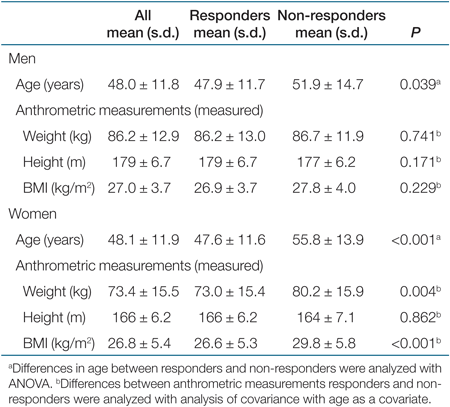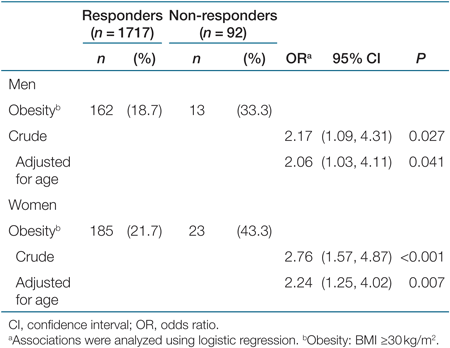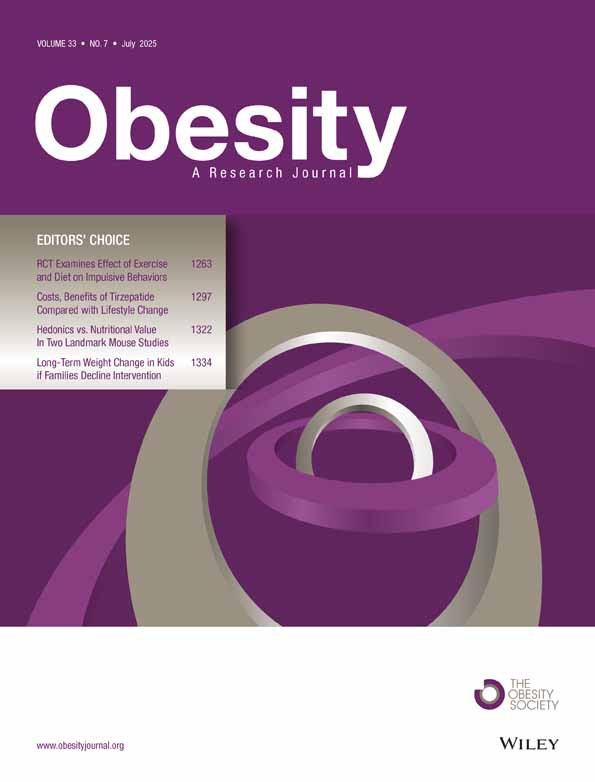What Is the Accurate Prevalence of Obesity in Sweden in the 21st Century? Methodological Experiences From the Skaraborg Project
Abstract
Objective: To examine the impact of non-response to self-reported body weight and height in health questionnaires for the estimation of obesity prevalence.
Methods and Procedures: A cross-sectional population-based health survey in the community of Vara with 16,009 residents (in year 2002) in South-western Sweden. Participants randomly selected in strata by sex and age among residents being 30–74 years old were consecutively invited to the local health care center for a health examination, including two visits. Self-reported information on body weight and height were obtained by health questionnaires at the first visit, and measured information on both variables at the second visit. For this study 1,809 subjects (904 men and 905 women) completed both visits (participation rate 81%), and a nurse measured body weight and height of all at visit two. Participants not self-reporting body weight and/or height at the first visit were defined as non-responders.
Results: Both male and female non-responders were significantly older than responders. Female non-responders had significantly higher BMI (29.8 ± 5.8 kg/m2) than female responders (26.6 ± 5.3 kg/m2), (P < 0.001). No similar findings were seen in men. Non-responders were more likely to be obese than responders both in men (odds ratio (OR) 2.06, 95% confidence interval (CI) 1.03–4.11) and in women (OR 2.24, 95% CI 1.25–4.02).
Discussion: Non-responders to self-reported body weight and height in health questionnaires contribute to the underestimation of obesity. Measured body weight and height are to prefer when describing the accurate prevalence of obesity in populations.
In the search for the accurate prevalence of obesity in a population, BMI ≥30 kg/m2 is often used as an easy and non-expensive standard measurement for relative weight (1,2,3,4,5). In order to collect data in populations measured or self-reported body weight and height are used (6,7). Measured data are based on invitations to a health survey, where the degree of obesity among those invited influence the participation rate and further the accuracy of the estimated prevalence of obesity, which tends to be underestimated (8,9). Self-reported BMI based on postal questionnaires or telephone interviews are also underestimated for the same reasons, but they are additionally biased due to the responders' systematic underestimations of their body weight and overestimation of their body height (6,7). In addition, age, sex, and degree of obesity of the non-responder to self-reported body weight and height might also bring in bias. The main aim of this study was to compare mean BMI and the prevalence of obesity between those who returned answers on body weight and height in a health questionnaire and those who did not, when they were unaware that their body weight and height were to be measured 2 weeks later.
Methods and procedures
Subjects
The Skaraborg Project comprises repeated cross-sectional health surveys in the population in Skaraborg (7,10). In 2001–2003, 1,811 inhabitants of Vara in Skaraborg (904 men and 907 women) participated, who were between 30 and 75 years of age. Participants, who were randomly selected from the population in strata by sex and age, were invited to participate in a health survey with two visits to one of two specially trained nurses at the local primary health care center. The second visit was performed 2 weeks after the first visit. At the first visit, participants were asked to answer a questionnaire, including self-reported body weight and height, which were recorded in kilograms and in centimeters, respectively. The participants did not at that time have any information on the anthropometric measurements that were to be included in the physical examination at the second visit. Measured weight (to the nearest 0.1 kg) and measured standing height (to the nearest centimeter) were assessed in light indoor clothes and no shoes, by the study nurses. The participation rate was 81% (men 80% and women 81%). Participants' missing information on measured body weight or height (n = 2) were excluded for this study, which thus includes 904 men and 905 women. Participants not answering the question of body weight and/or height at the first visit were defined as non-responders.
Assessment
BMI was calculated as body weight (kg)/height2 (m2) using measured data (2). BMI (kg/m2) was categorized into subgroups according to the World Health Organization (underweight: BMI <18.5, normal weight: BMI 18.5 to <25.0, overweight: BMI 25.0 to <30.0, and obesity: ≥30.0 kg/m2) (2). Subjects were further dichotomized into those who were non-obese (BMI <30.0 kg/m2) and into those who were considered obese (BMI ≥30.0 kg/m2), respectively (2).
Statistics
SPSS/PC 12.0 was used for all statistical analyses. All tests were two sided, and statistical significance was assumed at P <0.05. Numbers (n) and proportions (%), and mean (s.d.), were used for descriptive statistics. Differences in age between responders and non-responders were analyzed with ANOVA, and further differences in anthrometric measurements between responders and non-responders were analyzed with analysis of covariance with age as a covariate. Logistic regression models were used to estimate the associations between categorical variables and were expressed as odds ratios (ORs) with 95% confidence intervals (CIs).
Ethics
The regional ethical review board at the University in Göteborg approved the protocol. Participants provided a written informed consent to participate in the study at the first visit.
Results
Among the 1,811 participants in this study, 92 subjects (5.1%) did not answer the question on body weight and height in the health questionnaire. (Table 1). Male non-responders were older (mean age 51.9 ± 14.7 years) than responders (47.9 ± 11.7 years) (P = 0.039), and the same pattern was seen in women (mean age 55.8 ± 13.9 years vs. mean age 47.6 ± 11.6 years (P < 0.001). In women, the measured BMI was significantly higher in non-responders (BMI 29.8 ± 5.8 kg/m2) compared to responders (BMI 26.6 ± 5.3 kg/m2) (P < 0.001), but in men no such differences were seen (Table 1). Significant interactions were seen between sex and differences in measured body weight (P = 0.036) and BMI (P = 0.043) between responders and non-responders.
 |
Non-responders were more likely to be obese than responders (OR 2.54, 95% CI 1.21–2.79). In a multivariate analysis adjusting for age and sex, the differences decreased to OR 2.23 (CI 1.44–3.48). When accounting for differences in age, male and female non-responders were equally likely to be obese, in men OR was 2.06 (CI 1.03–4.11), and in women 2.24 (CI 1.25–4.02), respectively (Table 2). Male non-responders in this study contributed to an underestimation of the obesity prevalence of >1%, and female non-responders with >2%, respectively.
 |
Discussion
This study showed that women who did not respond to questions on body weight and/or height in self-administered questionnaires had a significantly higher BMI, and both male and female non-responders were significantly older and had a doubled risk of being obese. This should be added to other causes of underestimation when the accurate prevalence of obesity is looked for. The high participation rate and the low number of participants excluded due to missing information on body height and weight support the high quality of these data and provide a unique opportunity to elucidate implications for obesity epidemiology.
In Sweden, the prevalence of obesity is widely discussed, and Sweden is still defined as a country with a low prevalence of obesity compared to other Western countries (11,12). In a recent study based on measured data from the city of Göteborg, Sweden, in 2002, the prevalence of obesity was 14.8% in men and 11.0% in women. However, the participation rates were very low—36% in men (n = 486) and 43% in women (n = 546), and these prevalences were then probably underestimated (13). Another recent study from Sweden (participation rate 78%) using self-reported data showed a prevalence of obesity at 9.6% in men (n = 5,515) and at 9.3% in women (n = 5,838) (14). Again, for obvious reasons, this is a large underestimation of the accurate prevalence of obesity in Sweden. The prevalence in more rural areas in Sweden has recently shown a higher prevalence of obesity (7,15). In the very north of Sweden the combined prevalence of obesity in both sexes between 25 and 64 years of age was 18.4% using measured data (n = 1,145, 80%) (15). This is similar to the Skaraborg Project using measured data in Vara 2002. We found a prevalence of obesity in men at 20.1% and in women at 25.5%, respectively, in the ages of 30–75 years with corresponding high participation rates (80% in men and 81% in women) (7,16). This pattern emphasizes the higher prevalence of obesity found when using measured data and when participation rates are high. There are also gradients in the prevalence of obesity across levels of urbanization (14). This could be consistent with high prevalence found in northern Sweden and in the Skaraborg County.
Self-reported data have been shown to contribute to an underestimation of the obesity prevalence with ∼5% in an adult population (7). Furthermore, our findings clearly show that missing information on body weight and/or height in health questionnaires also significantly contribute to the underestimation of the obesity prevalence. Results from this study show that non-responders to self-reported information on body weight and/or height contribute with ∼2% to the underestimation of the obesity prevalence. In studies with self-administered questionnaires both external and internal dropouts should be accounted for.
Thus, according to available studies based on the most valid data, the prevalence of obesity among adults in Sweden are more likely to be over 20% than ∼10% (7,12,13,14,15,16).
In conclusion, the accurate prevalence of obesity is exposed to uncontrolled selections, biases in underestimation of body weight and overestimation of height, low participation rates, as well as not giving complete information in study questionnaires. Due to gender perspective systematic biases in self-reported information on body weight and BMI, obesity epidemiology based on questionnaires have low credibility, especially in females. Measured body weight and height are to prefer in describing the prevalence and secular trends of obesity. Also, precautions should be taken to secure higher participation rates and completion of questionnaires.
Disclosure
The authors declared no conflict of interest.
Acknowledgments
The study was supported by grants from the Skaraborg Institute, Swedish Medical Research Council and Skaraborg Primary Care, Sweden, The Health & Medical Care Committee of the Regional Executive Board of the Region Västra Götaland, Malmoe University Hospital, Region Skane and The Faculty of Medicine, Lund University, Sweden.





